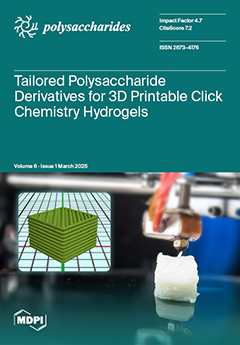Introduction. The rise of multidrug resistance in Gram-negative ESKAPE pathogens is a critical challenge for modern healthcare. Colistin (CT), a peptide antibiotic, remains a last-resort treatment for infections caused by these superbugs due to its potent activity against Gram-negative bacteria and the rarity
[...] Read more.
Introduction. The rise of multidrug resistance in Gram-negative ESKAPE pathogens is a critical challenge for modern healthcare. Colistin (CT), a peptide antibiotic, remains a last-resort treatment for infections caused by these superbugs due to its potent activity against Gram-negative bacteria and the rarity of resistance. However, its clinical use is severely limited by high nephro- and neurotoxicity, low oral bioavailability, and other adverse effects. A promising strategy to improve the biopharmaceutical properties and safety profile of antibiotics is the development of biopolymer-based delivery systems, also known as nanoantibiotics. Objective. The aim of this study was to develop polyelectrolyte complexes (PECs) for the oral delivery of CT to overcome its major limitations, such as poor bioavailability and toxicity. Methods. PECs were formulated using chondroitin sulfate (CHS) and a cyanocobalamin–chitosan conjugate (CSB12). Vitamin B12 was incorporated as a targeting ligand to enhance intestinal permeability through receptor-mediated transport. The resulting complexes (CHS-CT-CSB12) were characterized for particle size, ζ-potential, encapsulation efficiency, and drug release profile under simulated gastrointestinal conditions (pH 1.6, 6.5, and 7.4). The antimicrobial activity of the encapsulated CT was evaluated in vitro against
Pseudomonas aeruginosa. Results. The CHS-CT-CSB12 PECs exhibited a hydrodynamic diameter of 446 nm and a ζ-potential of +28.2 mV. The encapsulation efficiency of CT reached 100% at a drug loading of 200 µg/mg. In vitro release studies showed that approximately 70% of the drug was released within 1 h at pH 1.6 (simulating gastric conditions), while a cumulative CT release of 80% over 6 h was observed at pH 6.5 and 7.4 (simulating intestinal conditions). This release profile suggests the potential use of enteric-coated capsules or specific administration guidelines, such as taking the drug on an empty stomach with plenty of water. The antimicrobial activity of encapsulated CT against
P. aeruginosa was comparable to that of the free drug, with a minimum inhibitory concentration of 1 µg/mL for both. The inclusion of vitamin B12 in the PECs significantly improved intestinal permeability, as evidenced by an apparent permeability coefficient (P
app) of 1.1 × 10
−6 cm/s for CT. Discussion. The developed PECs offer several advantages over conventional CT formulations. The use of vitamin B12 as a targeting ligand enhances drug absorption across the intestinal barrier, potentially increasing oral bioavailability. In addition, the controlled release of CT in the intestinal environment reduces the risk of systemic toxicity, particularly nephro- and neurotoxicity. These findings highlight the potential of CHS-CT-CSB12 PECs as a nanotechnology-based platform for improving the delivery of CT and other challenging antibiotics. Conclusions. This study demonstrates the promising potential of CHS-CT-CSB12 PECs as an innovative oral delivery system for CT that addresses its major limitations and improves its therapeutic efficacy. Future work will focus on in vivo evaluation of the safety and efficacy of the system, as well as exploring its applicability for delivery of other antibiotics with similar challenges.
Full article





